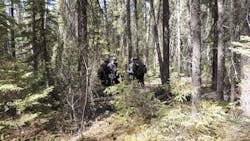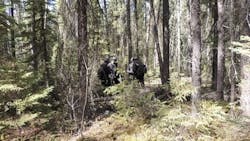A Calgary geophysical services firm has acquired ultrahigh-density 3D seismic data over a small area without seismic lines or trails using technology designed to reduce forest disturbance.
Explor Geophysical Ltd. said data density was 100 million traces/sq km at full offset with trace densities exceeding 42 million traces/sq km at target depth in its first noncommercial-scale application of the proprietary technology.
It shot the test survey through a riparian area where other methods are prohibited by regulators concerned about caribou.
Explor said typical low-impact seismic surveys in the forested oil sands region of Alberta require mulch lines 1-7.5-2.75 m wide, 30-80 m apart to accommodate equipment. Conventional surveys had line widths of 6-8 m.
Wolves still use the narrowest mulched lines to prey on boreal woodland caribou, Explor said, citing recent research.
The company conducted the test survey, without cutting any trees, outside the traditional winter operating season for seismic surveys in the boreal forest.
It said commercialization of the technology would enable operators of steam-assisted, gravity drainage projects to acquire seismic data throughout the year and in now-prohibited areas that create coverage gaps.
Typical uses of seismic data for SAGD operations include caprock imaging and reservoir characterization.



